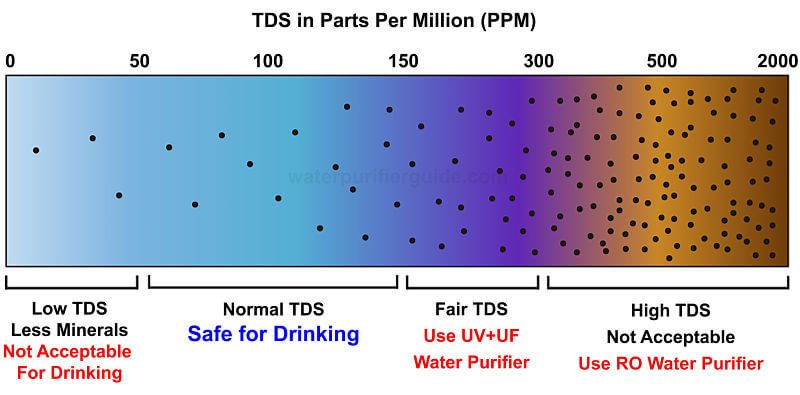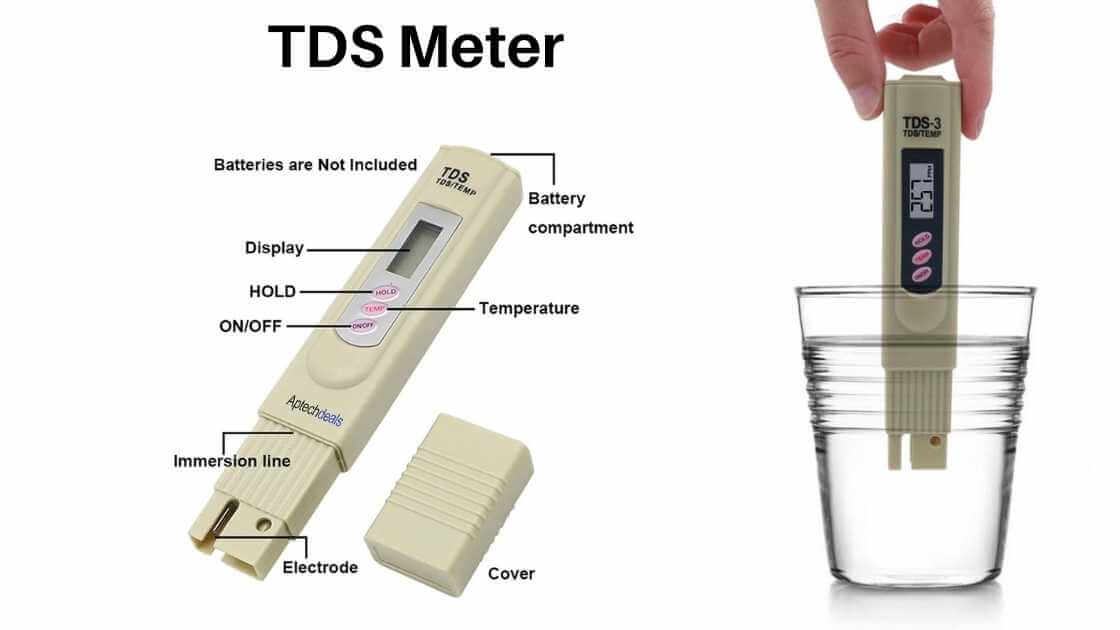

TDS stands for Total Dissolved Solids. In simple words, TDS is the dissolved contaminants in water such as salts, metals, sand particles and minerals that increase the hardness of water and make it impure. That is, the higher the TDS, the dirtier water and the less TDS, the cleaner water.
TDS is often measured in parts per million (ppm) or milligrams per liter of water (mg/l).
Table of Contents
How to Check the TDS Level of Water at Home?
TDS meter is a device used to check the TDS Level of water. It is very easy to use and you can easily buy it on Amazon.


How to use TDS meter Step by Step:-
- Take water from the direct water supply into a glass. Make sure that the water should Not be from the Water Storage Tank because if your water storage tank is dirty then it will show high TDS as compared to the direct water supply.
- Just switch on the TDS meter and pour it into the water and you can get the exact TDS level of water at your home.
- TDS level should be between 300-2000 ppm if you want to use an RO Water Purifier.
What should be the acceptable TDS level of drinking water?
Between 100-150 ppm is the most acceptable TDS level and safe for drinking. In most places in India, household water comes from municipal water supply (government water supply) or borewells. The average TDS from both sources is between 400-1200 ppm.
Don’t worry about which water purifier you should buy as RO Water Purifiers can purify water between 300-2000 ppm. If the TDS of water coming into your house is between 300-2000 ppm then it can be easily purified by RO Water Purifier and can give pure water with TDS between 30-50 ppm.
TDS below 50 ppm contains less minerals. Low TDS water is as harmful as high TDS water because if the TDS is below 50 ppm then the water lacks minerals which lead to poor digestion and weakening of bones and muscles. On the other hand, if the TDS is high, which is more than 500 ppm, then it is not worth drinking as it can cause diarrhoea, cholera, dysentery, typhoid.
Hence, it is necessary to adjust your TDS to the level which is necessary and ideal for consumption. Not every RO Water Purifier comes with a TDS Controller or Mineralizer Cartridge, so make sure to buy a water purifier that has a TDS Controller or Mineralizer Cartridge to add essential minerals into the water. It can help you to add essential minerals into the water and raise your TDS between 100-150 which is an ideal TDS level for drinking water and is good for health.
What if TDS is above 2000 ppm?
According to a Water TDS survey in India, it has been found that the average TDS of water is between 400-1200 ppm. TDS is high in some places and less in some places but TDS should not be more than 2000 ppm because if TDS is more than 2000 ppm then it is not useful in any way.
If the TDS of your house is more than 1500 ppm then you can complain to Jal Nigam. You can register your complaint on its Toll-Free number. Your complaint will be processed within 2 days.
Jal Nigam Toll-Free number: 1800-180-5678
What if TDS is below 300 ppm?
If the TDS of water is less than 300 ppm then you should not use an RO Water Purifier because the TDS of your water is low and it is good for drinking. But a little amount of contaminants and bacteria remain in water, for that you can use a UV+UF Water Purifier.
You can also use RO if you want but we recommend you to use a UV+UF Water Purifier if your TDS is less than 300 ppm.
Is high TDS water harmful?
Yes, drinking high TDS water is harmful as Water quality has deteriorated due to pollution and TDS level becomes high and that water is not good for drinking as it causes many health diseases.
High TDS water which is more than 500 ppm is not sufficient for drinking or cooking.
High TDS water that enters our homes contains salts, metals, sand particles and minerals. These 4 types of contaminants increase TDS. Salt, metals and sand particles in these 4 contaminants are harmful for consumption and should be removed from the water but minerals are essential for our health so it is allowed to remain in the water.
High TDS water causes health problems like diarrhoea, cholera, dysentery, typhoid.
Is low TDS water harmful?
Yes, drinking water with low TDS can be harmful. TDS below 50 ppm results in low minerals that can lead to poor digestion and weakening of bones and muscles.
Natural water contains some essential minerals like calcium, magnesium, potassium, sodium which are beneficial for our body. Therefore, it is not good to consume less than 50 ppm of water.
If you have no other option and you are drinking low TDS water then you should eat foods that are rich in minerals like fruits and green vegetables.
What should be the maximum TDS for RO system?
All the RO Water Purifiers can purify water up to 2000 ppm. If the TDS of your house water is more than 1500 ppm then you should use an RO Water Purifier with some conditions like TDS of water should be up to 2000 ppm and not more.
When the TDS of your water is between 1500-2000 ppm then your pre-filter starts collecting more dirt so it should be changed every 6 months as it removes large contaminants present in the water due to which the life of the RO filter increases. If it is not replaced in 6 months then it can cause problems and it can also block your RO filter.
You only need to change one pre-filter (which is installed outside the water purifier) every 6 months and the filters which are installed inside the water purifier are usually replaced once a year.
Best RO Water Purifier for Home as per TDS Level?
In India, the average TDS of domestic water ranges between 400-1200 ppm, so an RO Water Purifier is the best option for you as it can purify water up to a TDS between 300-2000 ppm.
See, the job of every water purifier is to Purify the dirty water and provide Pure drinking water. The differences come down to the level of their Features and Specifications. Nowadays water purifiers come with the latest technologies and innovations.
After searching for many water purifiers we are telling you the Most important feature which every water purifier should have and that is the TDS controller and Mineralizer. The work of both is the same, adding minerals into the water, just the way of working of both is different.
Therefore, before buying a water purifier, check whether it has a TDS Controller or a Mineralizer.


Difference between TDS Controller and Mineralizer:
TDS controller is a device used to add minerals into the water. It can be adjusted manually and you can control the TDS as per your requirement. A Mineralizer also known as Mineral Cartridge is a filter-shaped cartridge through which water passes and dispenses mineral water. Both can increase the TDS of water between 100-150 ppm so that you get mineral-rich water.
TDS Controller and Mineralizer are used in different situations. If the TDS of your household water is less than 700 ppm then only you can use a TDS Controller because it mixes a little UF purified water in RO purified water, which increases the minerals into the water and you get mineral-rich water.
And if the TDS of your water is more than 700 ppm, then you have to use Mineralizer only because it is not right to mix UF water with high TDS water. So this RO purified water which has very low TDS is passed through a Mineralizer Cartridge and you get mineral-rich water.
You can use a Mineralizer below 2000 ppm no matter what the TDS but the TDS Controller should only be used below 700 ppm.
